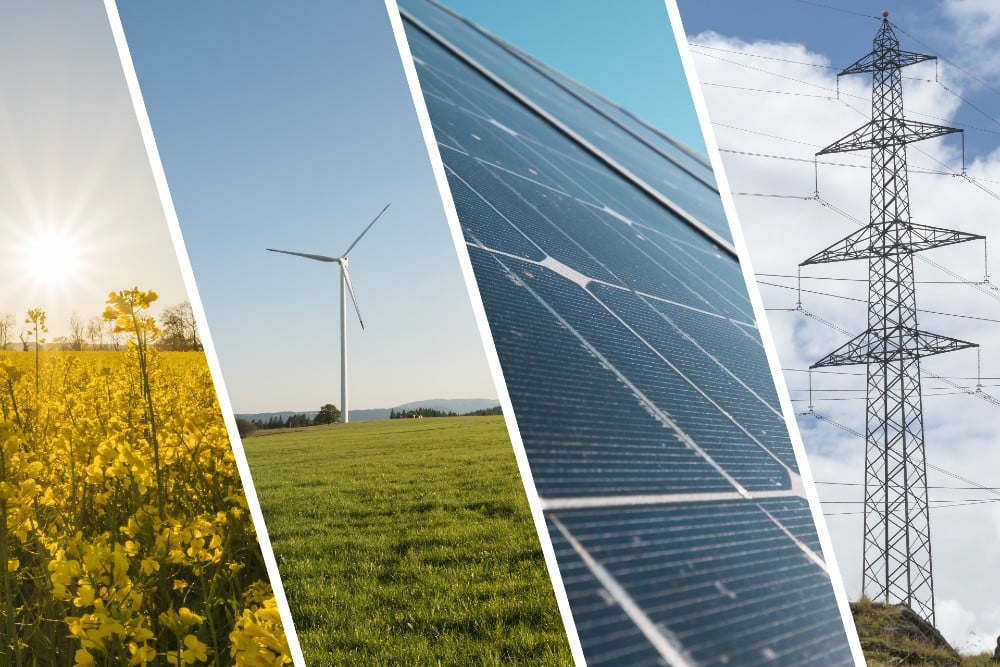One of the major issues dominating political debate and government policymaking is the need to develop sustainable alternatives to fossil fuels to meet global warming challenges. Oil and natural gas production and supply problems, fracking, the current inadequacies of wind and tidal power, and proposed laws mandating a transition to electric vehicles are generating headlines – and controversy – on a daily basis.
Corporate environmental responsibility is a major driver of the transition to renewable energy. Companies that understand emerging renewable energy and innovation trends, and can deliver affordable renewable energy solutions, are likely to prosper over the coming decade. Trends in the energy sector in 2023 are creating substantial opportunities, with a forward-looking focus on companies that can deliver energy conservation and efficiency solutions built around big data and new AI technologies.
ICL is a global leader with a proven track record for meeting sustainability challenges in the crucial global food, agriculture, and industrial markets. We’re genuinely excited by the possibilities inherent in renewable energy and innovation trends. We are planning a significant contribution to implementing renewable energy solutions in line with the 2023 trends and with marketable products that make a difference. Read on for our assessment of likely trends in renewable energy sources and how they can benefit us all.
From Fossil Fuels to Renewable Energy, Trends in 2023
Humans traditionally relied on wood, charcoal (and some coal burning) to meet the majority of their energy needs up to the industrial revolution. The advent of industrialization and the subsequent population explosion resulted in a dramatic increase in the use of fossil fuels.
During the first two centuries of industrialization, this expansion was largely limited to coal burning. Coal powered the new factories and mills, and heated the homes of the growing urban populations. Coal gas, extracted from coal in giant gasworks, provided lighting, before being replaced by electricity.
Generations of miners, often working in dangerous conditions for subsistence wages, paid a high human price to supply industrial and domestic consumers with cheap coal. Despite a partial transition to nuclear power, and new trends in renewable energy sources, many countries continue to use coal to generate electricity. According to Rysta Energy, as of November 2022, China’s electricity consumption for the year was expected to total 7,400 terawatt-hours (TWh) of which a massive 4,992 TWh is generated by burning coal.
City dwellers have suffered serious health problems from coal-induced pollution. Two salient examples of the hazards of fossil fuels to public health were the Greater London Smog of 1952 which caused the death of 12,000 people within 5 days, and the Aberfan Coal Mine disaster of 1966. Both tragic events occurred within living memory and in an advanced Western society.
The developing technologies of the twentieth century led to the distillation of crude oil as fuel for ships and new motor vehicles and aircraft. The post-war economic boom resulted in almost universal car ownership in the developed world, with many families owning more than one vehicle. The pollution caused by motor vehicles is immense. Oil products are also used for heating and as power sources in industry.
In developing nations, wood is still a primary domestic fuel source for cooking and heating. In addition to carbon pollution, non-sustainable forestry practices and the harvesting of firewood are contributing to soil erosion, flooding, and desertification. Centuries of fossil fuel use have caused massive environmental pollution and contributed directly to climate change.
Energy trends in 2023 – Consensus or Conflict?
There is considerable political wish (at least in many developed nations) to transition national economies away from dependence on fossil fuels. However, the transition away from fossil fuels has a negative economic impact on consumers causing adverse sentiments towards the use of clean and sustainable energy. .
The perception that the burden of adopting renewable energies is falling exclusively on Western societies, or may create dependency on foreign suppliers, adds to the controversies. Access to affordable energy is now an electoral issue in many major economies like the US, the UK, and the EU. In these turbulent times, it’s easy to lose sight of the big picture and the vital importance of a general transition to sustainable energy.
What is the Most Efficient Energy Source?
Just as beauty is in the eye of the beholder, the most energy-efficient source is defined by the resources available to the user. In resource-poor settings, firewood or kerosene may be the only energy sources available, whilst, in typical urban or suburban environments, oil delivered for boilers is used for winter heating of homes and businesses, with grid electricity satisfying the balance of their needs like air conditioning and appliances.
Assessment of the practical efficiency of energy is based on availability, safety, environmental impact, cost, continuity of supply, and renewability. In this context, fossil fuels are one of the least favorable sources in terms of environmental impact and renewability, although they are still the most widely used.
Efficient Sources of Energy
Nuclear power is by far the most efficient energy source and has the highest capacity factor (efficiency) when compared with coal, natural gas, solar, and wind sources. A typical nuclear plant can produce one gigawatt of electricity. It would take three coal-fired plants of one gigawatt to do the same. Nuclear is also favored because it outputs electricity 24/7.
Renewal sources like solar, wind or tidal, geothermal, or hydropower produce clean energy on an intermittent basis and therefore require elaborate storage facilities to make the energy constantly available.
In order to transition to renewable energy sources, considerable investment in infrastructure, transmission, and storage facilities must be made.

Key Drivers for Energy Transition
It’s clear that there is an impetus towards a transition away from fossil fuels. Trends in the energy sector in 2023 will continue towards greater electrification and energy efficiency. There are three main driving forces.
- High prices of fossil fuels and their environmental impact
The war in Ukraine, OPEC production policies, and US government energy policies are driving up the price of fossil fuels. Governments are suddenly nervous about energy dependence and energy blackmail, and some sections of the public prioritize safeguarding the environment over other concerns.
- Electrification
Electric vehicles and battery technology are transforming the concept of driving. Some jurisdictions are already drafting legislation to phase out the manufacture of vehicles with petrol engines. Energy trends in 2023 may include similar thinking in manufacturing, especially if there is a disruption to the supply of natural gas.
- Energy Efficiency
The rising cost of living and challenging economic conditions are increasing public demand for energy efficiency. Consumers are less tolerant of wasteful practices and sub-optimal infrastructures that drive up household energy bills and the cost of manufactured goods.
Energy Trends to Watch for in 2023
The most visible trends in the energy sector in 2023 won’t necessarily be the most important or innovative ones. Public attention will mainly be focused on the electrification of cars, and media reports about decarbonization and the shift to renewable energy sources. These have a more discernible impact on people’s lives and are already part of the cultural debate.
- Shift to Renewable Energy Sources
- Decarbonization
- Electrification of Cars
- AI and Big Data in the Energy Industry
- Sustainable Biomass
- Green Hydrogen Energy
We spoke to Yossi Ron, VP of Energy & Strategic Projects at ICL, who is passionate about the efficient and sustainable use of energy. His mantra is “Doing the right thing is also the best thing for the business in the long term!”
Arguably, the most exciting energy trends in 2023 will be the growing integration of AI and Big Data in the energy industry and the development of green hydrogen energy. Big Data and AI can potentially revolutionize energy efficiency across the board. AI algorithms can create an “intelligent coordination layer” that connects decentralized and localized energy production with the consumer base, accurately anticipating energy requirements.
The development of lower-cost and viable green hydrogen energy could transform several key industrial processes such as steel and cement manufacture, as well as transportation and heating.
Mr. Ron tells us “ICL’s vision for 2023 is energy conservation, efficiency, and photovoltaic (PV) panels on every available roof and in every open space. It is ICL’s intention to increase the use of renewables in the company’s energy portfolio by speeding up the development of renewable energy sources and storage within the group’s facilities worldwide. The flagship of the ICL efforts is the Green Sdom project aimed at eliminating roughly 1 million tons of carbon footprint generated by the Dead Sea Sdom site. The project will utilize significant amounts of solar energy generated locally and different types of Energy Storage (batteries, thermal, hydrogen, etc.) to create a self-sufficient hub or microgrid powered by clean energy and producing green products”
The shocks of the Covid-19 pandemic and the war in Ukraine, countries, and companies have been a wake-up call to try to mitigate their dependence on external sources by spurring the development of energy independence and greater and more efficient use of renewable energy, reduced usage, and the circular economy.
The major energy trend in 2023 will be the use of hydrogen. “2023 will be the year that green hydrogen moves from idea to reality around the world,” says Mr. Ron.
Hydrogen is color classified into a number of color codes by its environmental impact and renewability with green hydrogen being the most sustainable and black/brown the least. Grey hydrogen somewhere in the middle and made from methane or natural gas in a more sustainable way, is the most common form in use. Mr. Ron sees 2023 as the year of the initial transition from gray to green hydrogen.
He adds, “Sustainable energy is the wise exploitation of existing resources, and we must also be smart about consumption. Sustainable resources are those that exploiting doesn’t jeopardize our future.
In terms of electric vehicles (EV) and California’s vision of zero-emission electric vehicles by 2035, Mr. Ron is of the opinion that all EV manufacturers will most likely construct dedicated battery recycling facilities adjacent to their production plants.
Other predictions include the increased usage of green diesel produced by the pyrolysis of waste in sectors like aviation. 2023 will see ICL make major investments in sustainable energy projects. Sustainability will play a factor in profitability and will influence the ability to obtain loans for future projects.
Mr. Ron is also passionate about the reduction of landfill which cannot continue indefinitely. He believes that we should extract as much energy as possible from waste to improve circularity as well as energy usage.
ICL’s New $400 Million Dollar LFP Manufacturing Plant
ICL is poised to become a market leader in the global lithium battery industry supply chain. The group was awarded US government funding worth $197 million towards the creation of a new lithium iron phosphate (LFP) cathode active material (CAM) manufacturing plant in St. Louis. The $400 million dollar plant will place ICL at the heart of a Li-Ion battery market that is expected to be worth $240 billion by the year 2030.
The new 120,000-square-foot St Louis plant will run twin production lines, using state-of-the-art LFP technology to produce 30,000 metric tons of materials a year. The plant is a strategic venture that will make a significant contribution to US efforts to transform its energy infrastructure and make a smooth transition to clean and sustainable energy.
More on the subject:
The Next Energy Revolution
Sustainable Solutions for Energy Storage: Batteries, the Path for a
Renewable-Powered World
What is Renewable Energy?
ICL: At the Forefront of Renewable Energy Trends in 2023
The challenges of implementing a global shift towards sustainable energy sources are enormous and it is our vision to help create a better world with clean, affordable, and sustainable energy sources. The company has introduced energy-efficient circular economies to its own operations and builds sustainability into its own operating and production systems.
We are committed to developing innovative energy storage solutions to improve electrical storage capacity. New technology for bromine-based batteries for energy storage is transforming the potential of renewable energy storage.
At ICL, we are committed to implementing the United Nations 17 Sustainable Development Goals or SDGs. The 7th SDG is Affordable and Clean Energy. A substantial part of ICLs research and development effort is channeled into creating innovative new storage solutions for clean energy. This ties in directly with the group’s efforts in agriculture and food production – and its commitment to achieving the 2nd SDG of Zero Hunger.
We closely follow all trends in renewable energy sources and our expertise in chemical extraction and manufacture makes us a niche supplier to several energy producers. The goal is to innovate, improve, and anticipate emerging energy needs – and to deliver the products and services that will enable the global transformation to renewable and sustainable energy.







